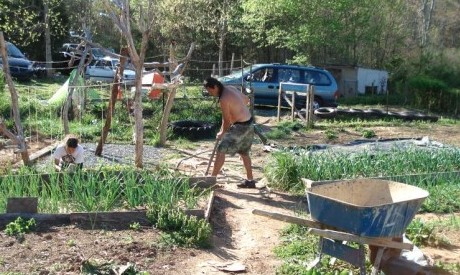“This brings me great joy,” said Chris Montesano, a long-time California farmer, with tears in his eyes. He beamed as he looked upon a room full of Catholic Worker farmers who had traveled from across the country for a recent gathering in Dubuque, Iowa. “We are at a historic moment in our movement’s history,” Montesano declared to the 60 eager listeners. After floundering for decades, Catholic Worker farms are now reclaiming their role at the center of the “Green Revolution” originally proposed by co-founder Peter Maurin.
Eighty years earlier, in 1933, Maurin—short, stocky, ragged and overly didactic with his thick French accent—had been the unlikely answer to Dorothy Day’s prayer for a vocation. Since her conversion to Catholicism in 1927, Day had longed for a synthesis that would reconcile her political radicalism and her newfound religious orthodoxy. For Maurin, Day was the eloquent, practical and thoroughly American companion to translate his idea for a Green Revolution into action. Maurin soon began sharing with the journalist his pithy, free verse writings, which he called “Easy Essays.” Many of these were summaries of books that greatly influenced his ideas, like the 1930 Southern Agrarian tract, I’ll Take My Stand.
The Green Revolution that Maurin proposed was a far cry from the movement of the same name spread by Norman Borlaug in the 1960s. Where the latter emphasized industrialism and synthetic fertilizers, Maurin’s movement harked back to the medieval Irish (hence “green”) monks who had saved civilization during the Dark Ages through their combination of “cult, culture and cultivation” (Maurin’s catchy idiom for worship, study and agriculture). Maurin’s nonviolent revolution centered primarily on creating farming communes where people could integrate the practices of growing organic food, praying together and offering hospitality to wayfarers and the poor in “Christ rooms.” Not wanting to abandon the urban poor, Maurin also advocated the establishment of city houses of hospitality for the homeless (the most well-known aspect of the Catholic Worker).
Initially, though, the Green Revolution would be fomented by starting a newspaper for disseminating Maurin’s theory. On May Day 1933, Maurin and Day commenced their movement by passing out 3,000 copies of The Catholic Worker. Three years later, joined by a growing number of volunteers, they announced their search for land and financial support with the audacious headline: “To Christ—To The Land!” Continue reading
Sources
- America
- Image: Sacred Run 2006
